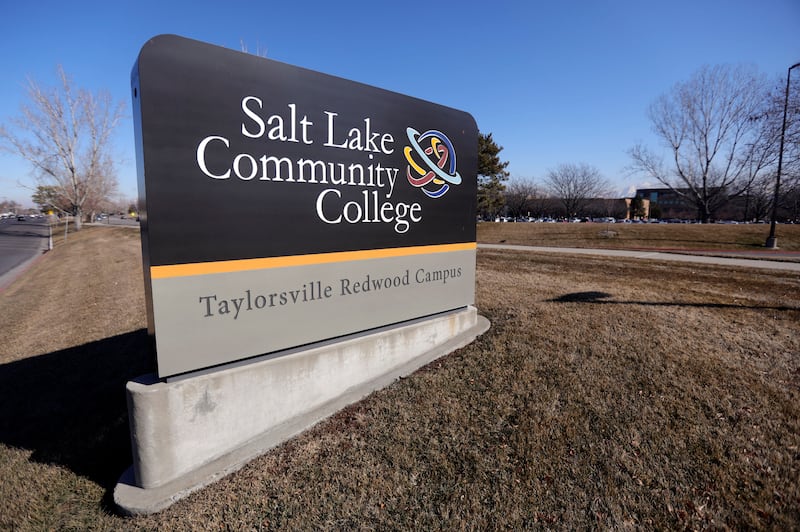LEHI — After the pandemic forced colleges and universities to make a sudden shift to virtual learning this past spring, leaders of two Utah institutions of higher education say the lasting result will likely be continued reliance on technology while bolstering in-person learning for small-group problem-solving and experiential learning.
University of Utah President Ruth Watkins, speaking on the future of higher education during a virtual Silicon Slopes Town Hall Friday, said lecture halls full of students passively listening to a “sage on the stage” has little value.
“There’s a lot of better ways to do that so let’s do that, but then use your in-person time for experiential, interactive problem-solving, group work. Use in-person for what it’s good for and use technology for what it’s good for. I think we are doing that now and we need to do it more, better and faster,” Watkins said.
Salt Lake Community College President Deneece Huftalin said many college professors have been offering those “flipped classroom” experiences for a decade.
“There’s some things that have been in our portfolio for many years that I think we’re going to ramp those up and highlight them even more and we’ll learn and build even better experiences,” she said.
SLCC faculty have developed “remarkable ways” to work with students to work on “real problems in our society” through undergraduate research, study abroad or service learning, Huftalin said.
“A lot of what we’re doing with our teachers is really helping them think about high-impact practices and how to engage students much more actively when they’re in person,” she said.
Huftalin said the pandemic laid bare the nation’s and Utah’s “economic divide.”
While the head count across the Utah System of Higher Education was flat this fall, SLCC’s enrollment was down 7.5%, which was troubling considering the community college’s tuition is among the lowest in the state and it offers sizable scholarship and financial aid packages, she said.
“Still students felt like they couldn’t come so that tells you something, right? That tells you something about the financial situation that some of our students are in. I really worry that we’ve got to find a way to close that economic divide and be really mindful about what’s happening in our communities that’s splitting these people and creating the fact that it’s an opportunity cost for them to come to college,” Huftalin said.
Somehow, Utah leaders need to figure out how to help students reengage so they can complete their certificate programs or degrees. Utah has one of the highest percentages of some college but no degree, she said.
“I don’t know about you, but when I look at a resume I don’t look at the number of credits that someone earned. I look to see whether they’ve got a degree or credential,” she said.
Asked if colleges and universities feel threatened by industry-led initiatives such as Google’s new certification programs that can be completed in six months and industry plans to treat the certifications as the equivalent of four-year degrees for certain roles, both Watkins and Huftalin pushed back on the use of the word “threat.”
“Threats is not the right way to think about this. This is an opportunity and the pandemic has opened some new doors for us. So one of the things we don’t do as well as we could in post-secondary ed is connecting with industry. What does industry need? What does industry want from a skill set?” Watkins said.
Huftalin said community colleges have offered short-term, highly focused certificate programs since their inception.
“That’s not really a new concept. It’s new that Google’s launching it, but it’s not necessarily new to us in terms of really reducing a skill set to a very short-term, focused program and I think that’s really important, especially right now. In our Learn to Work program we saw students, people coming back to school, immediately with the pandemic to say, ‘I’ve got to get retrained quickly. I need a focus skill and I got to get back into the workforce,’ ” Huftalin said.
Watkins said a short-term, skill-based program is “actually the most at risk of being obsolete.”
Students need to think of higher education as a continuum where there is a role for a workforce credential but also a need for skills and competencies learned at degree-granting institutions that allow them to advance in their careers, she said.
“They don’t have to be separate pathways for different people. It can be the same person at different times in their life,” Watkins said.
The U. and SLCC partner on many initiatives that ease credit transfers and recognize starting at the community college is more affordable for many students.
Huftalin and Watkins said the two institutions plan to take that cooperation to the next level with SLCC’s planned educational building in Herriman where students will be able to attend classes offered by the community college and the U.
Huftalin said the Utah Legislature had appropriated funding for the project, but it was pulled back when lawmakers had to cut the state budget due to the pandemic. Hopefully the Legislature will restore the funding during the upcoming legislative session, she said.
“There’s a huge pipeline in junior high and high school out there that really needs access to higher ed. They also really appreciate the partnership, this idea that we’re working together, that we’re being more efficient with our dollars, and that we’re saving air quality from having to have to travel clear across the valley to move to another degree.
“It’s just a win, win, win in my mind,” Huftalin said.


